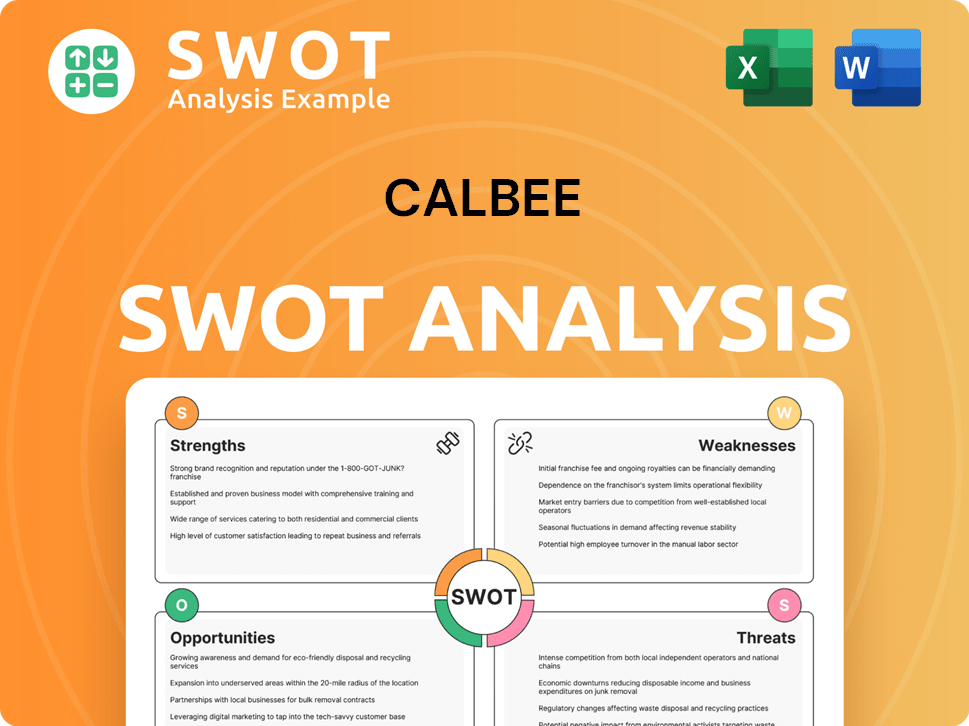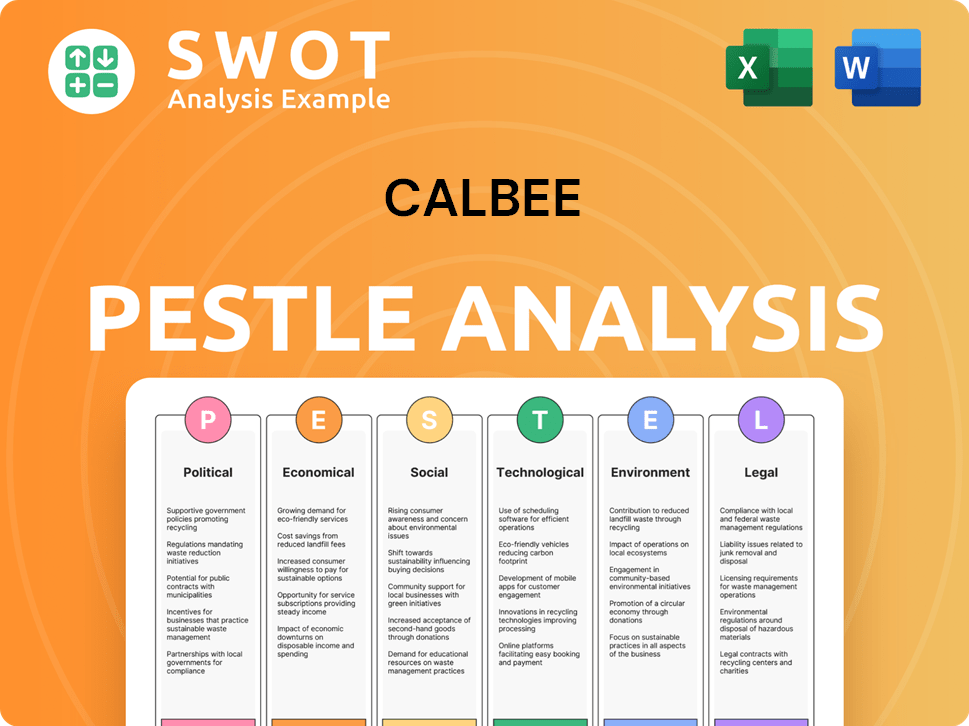Calbee Bundle
How Does the Calbee Company Stay Ahead?
Calbee, a leading Japanese snack company, tantalizes taste buds worldwide with its beloved potato chips, shrimp crackers, and innovative treats. With a strong presence in the global savory snack market, Calbee's commitment to quality and innovation has solidified its position. As of March 2024, the company demonstrated its financial prowess with ¥283.4 billion in consolidated net sales.

This exploration into the Calbee SWOT Analysis will uncover the secrets behind the Calbee business model, from its core Calbee operations to its strategic market maneuvers. We'll examine how this Japanese snack company has grown into a global powerhouse, offering valuable insights for investors and industry enthusiasts. Discover the intricacies of a potato chip manufacturer that has captured hearts and markets worldwide, understanding the ingredients of its sustained success.
What Are the Key Operations Driving Calbee’s Success?
The core operations of the Calbee company are centered on the production and distribution of savory snacks, targeting a broad consumer base including children and adults. Its primary offerings include potato chips, such as 'Potato Chips Usushio (Lightly Salted)' and 'Potato Chips Consommé Punch,' alongside iconic products like 'Kappa Ebisen' shrimp crackers. The company also produces a variety of other snacks, including 'Jagarico' potato sticks and 'Frugra' cereal products, catering to diverse tastes.
The operational process begins with the careful sourcing of high-quality ingredients, particularly potatoes, essential for many of its products. Calbee business model emphasizes sustainable agricultural practices, frequently partnering with farmers to ensure a stable supply of premium raw materials. Advanced technology and stringent quality control measures are employed throughout the manufacturing process to maintain consistent, high-quality snacks, including specialized frying and baking techniques.
Logistics and distribution are crucial, with Calbee operations managing a robust supply chain to reach a vast network of retailers. This includes supermarkets, convenience stores, and online platforms, both domestically and internationally. The company's focus on innovation, brand recognition, and an extensive distribution network translates into significant customer benefits, offering diverse, high-quality, and readily available snack options.
The Japanese snack company sources high-quality ingredients, especially potatoes. Manufacturing involves advanced technology and strict quality control. This includes specialized frying and baking techniques to enhance flavor and texture for products like potato chips and Kappa Ebisen.
Calbee's products are distributed through an extensive network of retailers. This includes supermarkets, convenience stores, and online platforms. The company's strong distribution network ensures its products are readily available to consumers across various channels.
Calbee frequently introduces new flavors and product variations. The company's deep understanding of consumer preferences and investment in research and development drive this innovation. This agility in product development helps to maintain consumer interest and market relevance.
Calbee benefits from strong brand recognition and a wide distribution network. This translates into offering consumers diverse, high-quality, and easily accessible snack options. These factors differentiate Calbee in a competitive market.
Calbee distinguishes itself through a blend of traditional Japanese craftsmanship and modern innovation. Continuous investment in research and development allows for the frequent introduction of new flavors and product variations. This approach, combined with its strong brand recognition and extensive distribution network, offers significant customer benefits.
- Focus on high-quality ingredients, particularly potatoes.
- Emphasis on sustainable agricultural practices and partnerships with farmers.
- Use of advanced manufacturing technology and stringent quality control.
- Agility in product development and introduction of new flavors.
For more detailed information on the company's structure, you can refer to Owners & Shareholders of Calbee. As of the latest reports, Calbee continues to demonstrate robust financial performance, with a focus on expanding its product line and global presence. The company's commitment to innovation and efficient operations has allowed it to maintain a strong position in the competitive snack market. The company’s strategic initiatives are centered on enhancing operational efficiency and expanding its product portfolio to meet evolving consumer preferences. Recent market analyses indicate that Calbee's revenue streams are diversified across various product categories and geographical regions, reflecting its strategic approach to market expansion.
Calbee SWOT Analysis
- Complete SWOT Breakdown
- Fully Customizable
- Editable in Excel & Word
- Professional Formatting
- Investor-Ready Format

How Does Calbee Make Money?
The Calbee company generates revenue primarily through the sale of its snack products. These products are distributed via various retail channels, with a significant portion of sales originating from its domestic market. The Calbee business model focuses on volume sales and competitive pricing, leveraging its strong brand and extensive distribution network.
In the fiscal year ending March 31, 2024, the company reported consolidated net sales of ¥283.4 billion. This revenue is driven by a diverse portfolio that includes potato chips, shrimp crackers, and cereal products. International operations, particularly in North America and other Asian markets, are increasingly contributing to the overall revenue.
The Calbee operations include a focus on product diversification and international expansion to broaden its revenue base. This strategy helps mitigate risks associated with over-reliance on a single product type or region, ensuring sustained growth and market presence.
The core of Calbee's revenue comes from its snack products, including potato chips and other snack foods. Monetization is achieved through high-volume sales and competitive pricing strategies. The company employs various tactics to boost sales, such as seasonal releases and collaborations, to keep consumer interest high. For more information on the Calbee target market, check out this article Target Market of Calbee.
- The domestic snack business is a major revenue contributor.
- International operations, especially in North America and Asia, are growing in importance.
- Product diversification includes healthier options like 'Frugra' cereals.
- Expansion into new markets, such as China, is a key strategy.
Calbee PESTLE Analysis
- Covers All 6 PESTLE Categories
- No Research Needed – Save Hours of Work
- Built by Experts, Trusted by Consultants
- Instant Download, Ready to Use
- 100% Editable, Fully Customizable

Which Strategic Decisions Have Shaped Calbee’s Business Model?
The Calbee company has a rich history of strategic initiatives and key milestones that have significantly shaped its trajectory. Its journey is characterized by a strong emphasis on innovation, which has led to the creation of iconic products such as 'Kappa Ebisen' and its initial potato chips. Furthermore, the company's strategic expansion into international markets and partnerships have been pivotal in broadening its global presence and diversifying revenue streams.
A critical aspect of Calbee's business model involves managing operational challenges, including fluctuating raw material prices and supply chain disruptions. The company has responded by fortifying relationships with suppliers, investing in stable sourcing strategies, and optimizing logistics to ensure consistent product availability. These proactive measures have been essential in maintaining operational efficiency and adapting to market dynamics.
The Calbee operations are underpinned by several competitive advantages. These include robust brand recognition, technological leadership in snack manufacturing, economies of scale in production and distribution, and a strong commitment to research and development. This comprehensive approach enables the company to maintain a strong portfolio of beloved brands while simultaneously innovating new products, thereby sustaining its competitive edge.
The launch of 'Kappa Ebisen' in 1964 and the first potato chips in 1975 were pivotal moments. These products quickly became household staples in Japan, establishing a strong market presence. Strategic expansion into international markets, particularly North America and China, has been a key driver of growth.
Partnerships, such as the joint venture with PepsiCo in North America, have been crucial for expanding global reach. The company has focused on improving production efficiency and optimizing its product portfolio. This includes strengthening relationships with farmers and investing in stable sourcing strategies to manage raw material costs.
Strong brand recognition, built over decades, fosters significant customer loyalty. Technological leadership in snack manufacturing allows for superior product quality and differentiation. Economies of scale in production and distribution provide a cost advantage. The company's commitment to research and development enables it to continuously adapt to new trends.
Fluctuations in raw material prices, particularly for potatoes, pose a significant challenge. Supply chain disruptions can impact product availability. The company addresses these challenges by strengthening supplier relationships and optimizing logistics. Adapting to changing consumer preferences is also crucial.
In recent financial reports, the company has demonstrated resilience and growth. For example, in fiscal year 2024, the company reported a revenue increase, driven by strong sales in both domestic and international markets. The company's strategic focus on innovation and efficiency has helped maintain profitability despite rising costs. The company continues to invest in research and development to stay ahead of market trends.
- Revenue growth driven by strong sales performance.
- Strategic investments in innovation and efficiency.
- Expansion in key international markets to diversify revenue streams.
- Focus on sustainable sourcing and supply chain management.
Calbee Business Model Canvas
- Complete 9-Block Business Model Canvas
- Effortlessly Communicate Your Business Strategy
- Investor-Ready BMC Format
- 100% Editable and Customizable
- Clear and Structured Layout

How Is Calbee Positioning Itself for Continued Success?
The Calbee company holds a leading position in the Japanese snack food market, with a substantial and growing international presence. It competes with global giants and local players across various regions. Calbee's strong brand loyalty in Japan and its expanding market share in North America and parts of Asia underscore its robust competitive standing. As of March 2024, the company's consolidated net sales reflect its significant industry footprint. For a deeper dive into their mission, explore the Growth Strategy of Calbee.
Despite its strong market position, Calbee faces several risks. These include volatility in raw material costs, especially for potatoes, which can impact profitability. Changing consumer preferences toward healthier eating habits pose a continuous challenge, requiring ongoing innovation in product development. Intense competition in both domestic and international markets, coupled with potential regulatory changes, also represent risks. The Calbee business model is constantly adapting to these challenges.
As a Japanese snack company, Calbee dominates the domestic market and expands internationally. It competes with major players like PepsiCo and local brands. The company's brand loyalty and market share growth highlight its strong competitive standing.
Raw material cost volatility, especially for potatoes, affects profitability. Consumer demand for healthier snacks requires continuous innovation. Intense competition and regulatory changes pose ongoing challenges for Calbee operations.
Calbee plans further international expansion, particularly in high-growth markets. Innovation in product development and health-conscious snacks remains crucial. The company aims to enhance operational efficiency and optimize its supply chain.
Calbee focuses on international expansion and creating new products. It invests in research and development to meet evolving consumer tastes. The company is committed to sustainable growth and leveraging its brand for global reach.
Calbee is actively pursuing strategic initiatives to sustain and expand its profitability. The company is focused on further international expansion, particularly in growth markets. Innovation remains a cornerstone of its future outlook.
- Expanding into new international markets.
- Investing in research and development for new products.
- Enhancing operational efficiency and optimizing the supply chain.
- Leveraging its strong brand and product innovation.
Calbee Porter's Five Forces Analysis
- Covers All 5 Competitive Forces in Detail
- Structured for Consultants, Students, and Founders
- 100% Editable in Microsoft Word & Excel
- Instant Digital Download – Use Immediately
- Compatible with Mac & PC – Fully Unlocked

Related Blogs
- What are Mission Vision & Core Values of Calbee Company?
- What is Competitive Landscape of Calbee Company?
- What is Growth Strategy and Future Prospects of Calbee Company?
- What is Sales and Marketing Strategy of Calbee Company?
- What is Brief History of Calbee Company?
- Who Owns Calbee Company?
- What is Customer Demographics and Target Market of Calbee Company?
Disclaimer
All information, articles, and product details provided on this website are for general informational and educational purposes only. We do not claim any ownership over, nor do we intend to infringe upon, any trademarks, copyrights, logos, brand names, or other intellectual property mentioned or depicted on this site. Such intellectual property remains the property of its respective owners, and any references here are made solely for identification or informational purposes, without implying any affiliation, endorsement, or partnership.
We make no representations or warranties, express or implied, regarding the accuracy, completeness, or suitability of any content or products presented. Nothing on this website should be construed as legal, tax, investment, financial, medical, or other professional advice. In addition, no part of this site—including articles or product references—constitutes a solicitation, recommendation, endorsement, advertisement, or offer to buy or sell any securities, franchises, or other financial instruments, particularly in jurisdictions where such activity would be unlawful.
All content is of a general nature and may not address the specific circumstances of any individual or entity. It is not a substitute for professional advice or services. Any actions you take based on the information provided here are strictly at your own risk. You accept full responsibility for any decisions or outcomes arising from your use of this website and agree to release us from any liability in connection with your use of, or reliance upon, the content or products found herein.